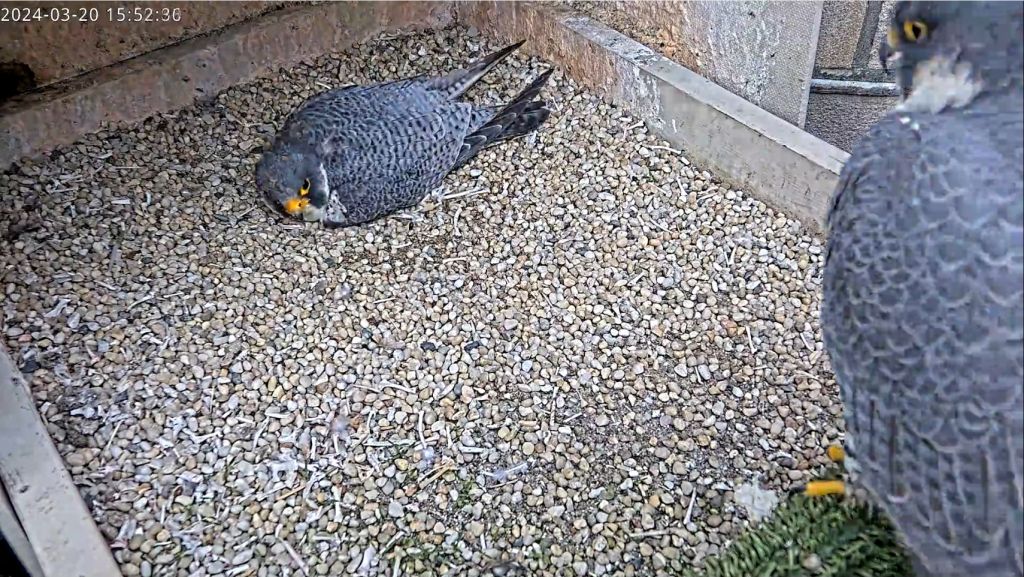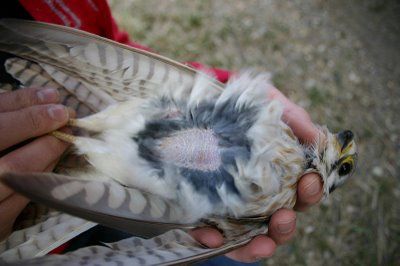
24 March 2024
Incubation began last week at the Pitt peregrine nest. Carla and Ecco are now 6 or 7 days into The Big Sit.
To incubate their eggs and brood their chicks, birds open their warm feather coats by developing a brood patch for the breeding season. The brood patch is bare skin on their bellies that they place directly against the eggs to keep them warm. It has no feathers or down and lots of blood vessels close to the surface. When the bird is standing upright, surrounding feathers fall over the patch to cover it. If you had the bird in hand, as this bander holds a kestrel, blowing on the bird’s belly will move the surrounding feathers away so you can see the brood patch.

Both male and female peregrines have brood patches and both incubate the eggs. Instead of one big patch as on the kestrel, Birds of the World describes peregrines as: “Both sexes have paired lateral brood patches. Less well developed in male.”
To expose the brood patch and incubate the eggs, peregrines move the surrounding feathers out of the way by bobbing up-and-down and side-to-side. In this video Carla turns the eggs with her feet, then bobs to open her brood patch before she settles on the eggs.
Female peregrines incubate all night (with this interesting exception) but the amount of time the male incubates during the day depends on the couple’s preferences.
Some males love incubation duty, others not so much. Birds of the World sites several studies (paraphrased): “Based on studies in interior Alaska, males incubated about 33% of time. A study by Nelson suggested that for the Pacific Northwest male, incubation was 30–50% of the time. An extreme case in New Mexico was a male incubating as much as 87% of daylight period.”
Ecco loves to incubate so Carla and Ecco are still working it out. In this 20 March video Carla wails off camera “I want something to change!” Yup. She wants to incubate. Ecco eventually gets the message.
Peregrine eggs hatch 33-35 days after incubation begins but when did it start at the Cathedral of Learning?
Typically incubation starts after the next-to-last egg is laid — that would be Egg #3 on 19 March at 2am — but it looks like it may have begun on the 18th before that egg was laid.
Two Day-in-a-Minute videos illustrate the difference between incubating and not. This one on 17 March shows that the two eggs are often exposed.
On 19 March there are 3 eggs and incubation has definitely begun. Notice that Ecco is on the nest more than half the time on that day –> 54%. He’s the smaller bird and is present 390 minutes out of 720 mins in the video. No wonder Carla wailed at him on the 20th!
So incubation began on either the 18th or 19th of March. It is hard to tell about the 18th because it was cold that day (28°F to 36°F) and Carla and Ecco may have covered the eggs to protect them from freezing without opening their brood patches(*).
We’ll never know for sure whether the brood patch was open because we can’t see under the bird.
Carla and Ecco have 27 to 30 days to go for The Big Sit at Pitt. Watch them on the National Aviary Falconcam at Univ of Pittsburgh.
(photos and videos from the National Aviary Falconcam at Univ of Pittsburgh)
(*) EXPLAINING DELAYED INCUBATION: Some species, such as bald eagles, incubate immediately as soon as an egg is laid. Within these clutches the chicks hatch days apart from each other. Others species, such as peregrine falcons and ducks, want the clutch to hatch all at once so they delay incubation until the clutch is (nearly) complete. During freezing weather the eggs must be protected from freezing. Covering them without opening the brood patch is one way to regulate the start of incubation.